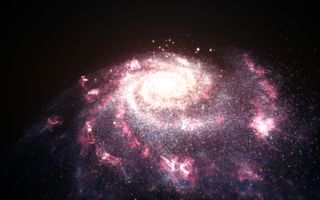
This illustration shows a messy, chaotic galaxy undergoing bursts of star formation.
(Image credit: ESA, NASA, L. Calçada)
Astrophysicists may have an explanation for the James Webb Space Telescope’s discovery of a swarm of mysterious early galaxies that threaten to break cosmology.
The galaxies, which the James Webb telescope (JWST) spotted forming as early as 500 million years after the Big Bang, were so bright that they theoretically shouldn’t exist: Brightnesses of their magnitude should only come from massive galaxies with as many stars as the Milky Way, yet these early galaxies took shape in a fraction of the time that ours did.
The discovery threatened to upend physicists’ understanding of galaxy formation and even the standard model of cosmology. Now, a team of researchers using supercomputer simulations suggest that the galaxies may not be so massive at all — they could just be unusually bright. The researchers published their findings Oct. 3 in the Astrophysical Journal Letters.
Related: James Webb telescope finds potential signature of life on Jupiter’s icy moon Europa
“Typically, a galaxy is bright because it’s big. But because these galaxies formed at cosmic dawn, not enough time has passed since the Big Bang. How could these massive galaxies assemble so quickly?” Senior study author Claude-André Faucher-Giguère, an astrophysicist at Northwestern University, said in a statement. “Our simulations show that galaxies have no problem forming this brightness by cosmic dawn.”
Scientists don’t know exactly when the first clumps of stars began to merge into the beginnings of the galaxies we see today, but cosmologists previously estimated that the process began slowly taking shape within the first few hundred million years after the Big Bang.
Currently accepted theories suggest that these early protogalaxies reached adolescence 1 to 2 billion years into the universe’s life — forming into dwarf galaxies that began devouring each other to grow into ones like our own.
This made the JWST’s discovery of thousands of unusually bright early galaxies, some even resembling our own, a bewildering surprise for astronomers. It was a discovery that put their most basic understanding of how the universe evolved into severe doubt. If these galaxies were like ours, to glow so bright they would need to have swollen to enormous sizes in a fraction of the usual time.
To investigate what could have given these galaxies their strange sparkle, the researchers created a model of galaxy formation and ran it through a supercomputer — simulating the swirling, clotting gas of the early universe as it turned into stars, which in turn formed into galaxies.
By carefully accounting for the mass, energy, momentum and chemical composition of the young universe, the researchers found that stars at this early time could have formed in sudden, rapid bursts after years of quiescence. Known as “bursty star formation,” the process is unlike the steady rate of star birth in today’s universe and could explain why the early universe is so bright.
In the early universe, stars were born by sucking gas toward them before pushing it out again upon their deaths in stellar explosions known as supernovas. This heartbeat of gas, pulsing in then out, enabled stars to form in rapid, bright bursts after millions of years of dormancy. Later, as the universe aged and galaxies got bigger, their gravity became too strong for gas to be ejected by supernovas, forcing stars to form at a more sedate pace.
If the bursty star formation hypothesis is correct, the galaxies that the JWST detected are brighter because we are viewing their stars form in these sudden bursts, not because they contain as many stars as those in the present day.
“Most of the light in a galaxy comes from the most massive stars,” Faucher-Giguère said. “Because more massive stars burn at a higher speed, they are shorter lived. They rapidly use up their fuel in nuclear reactions. So, the brightness of a galaxy is more directly related to how many stars it has formed in the last few million years than the mass of the galaxy as a whole.”
If the astrophysicists’ simulations are right, our standard view of the universe will have, somewhat disappointingly, survived. But astronomers will need to take more precise readings of the mysterious galaxies at cosmic dawn before they can know for certain.
Stay up to date on the latest science news by signing up for our Essentials newsletter.
Ben Turner is a U.K. based staff writer at Live Science. He covers physics and astronomy, among other topics like tech and climate change. He graduated from University College London with a degree in particle physics before training as a journalist. When he’s not writing, Ben enjoys reading literature, playing the guitar and embarrassing himself with chess.
>>> Read full article>>>
Copyright for syndicated content belongs to the linked Source : Live Science – https://www.livescience.com/space/cosmology/james-webb-telescopes-observations-of-impossible-galaxies-at-the-dawn-of-time-may-finally-have-an-explanation










